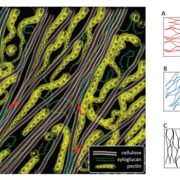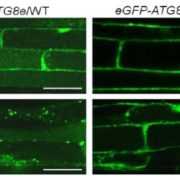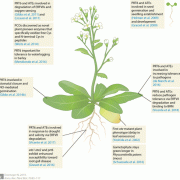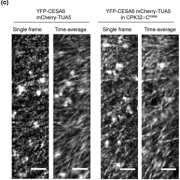Gravisensors in plant cells behave like an active granular liquid (PNAS)
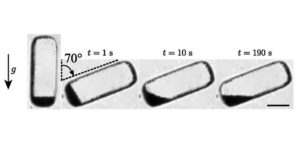 When you try to tip rocks out of a bucket, nothing happens until the steepness of the angle is sufficient to start them shifting (the “avalanche angle”). By contrast, water starts moving with even the slightest tilt to the bucket. Now think about the gravity sensing particles in plant cells, starch-rich statoliths, which are quite large relative to the cells that contain them. Bérut et al. asked how plant gravity responses can be so fine when their gravity sensing machinery appears so course. By observing the behaviour of lots and lots of statoliths, the authors concluded that statoliths act more like water than rocks; or actually, like rocks that are being agitated, causing them to unjam and behave like a fluid. Using a biomimetic approach, the authors ruled out thermal or Brownian sources, and conclude that the agitation stems from cell activity, specifically the dynamics of the actin cytoskeleton, consistent with previous studies using inhibitors of the actin cytoskeleton. In addition to really cool findings, this paper has terrific videos! (Summary by Mary Williams) Proc. Natl. Acad. Sci. USA 10.1073/pnas.1801895115
When you try to tip rocks out of a bucket, nothing happens until the steepness of the angle is sufficient to start them shifting (the “avalanche angle”). By contrast, water starts moving with even the slightest tilt to the bucket. Now think about the gravity sensing particles in plant cells, starch-rich statoliths, which are quite large relative to the cells that contain them. Bérut et al. asked how plant gravity responses can be so fine when their gravity sensing machinery appears so course. By observing the behaviour of lots and lots of statoliths, the authors concluded that statoliths act more like water than rocks; or actually, like rocks that are being agitated, causing them to unjam and behave like a fluid. Using a biomimetic approach, the authors ruled out thermal or Brownian sources, and conclude that the agitation stems from cell activity, specifically the dynamics of the actin cytoskeleton, consistent with previous studies using inhibitors of the actin cytoskeleton. In addition to really cool findings, this paper has terrific videos! (Summary by Mary Williams) Proc. Natl. Acad. Sci. USA 10.1073/pnas.1801895115
[altmetric doi=”10.1073/pnas.1801895115″ details=”right” float=”right”]


